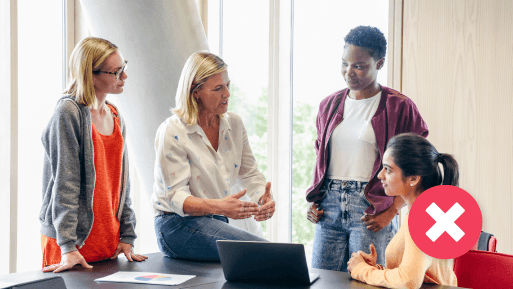Our students and staff
Our leading photographic style depicts real University of Hertfordshire students and staff hard at work and play in recognisable, modern and open environments.
Images should have an authentic, realistic feel to it. These images must feel true to life and not staged – as if you have just popped into their classroom or workspace to see what they are doing that day. These background environments should give context to the subjects’ interests, course or role at the University, and have the dual purpose of showcasing our beautiful campus and facilities.
The images should always use real students and colleagues and it is important to consider diversity in your imagery selections, reflecting our diverse and colourful community.
Style must haves | - The crops of the imagery are key to the style. By always cropping from at least the waist up you ensure the image has a stronger focus and creates a personal connection with the student. The crops also suggest a boldness from the students - they are not afraid to show their personality.
- Images should create an emotional connection between the subject and audience, and reinforce that strength of personality and confidence in conviction of our people.
- Our approach to photography is based around our aim to show the persons potential, ambition and energy and that we are a place of diversity and opportunity. Our images are united in the way they focus on people and exude confidence and positivity.
|
|---|
Briefing your photographer | - When capturing a student or colleague in their environment, make sure they look and feel relaxed. They must look engaged and positive
- Each individual’s personality should shine through – if they are outgoing and confident, then a more candid pose is relevant. If they are more serious and quieter, then they should not be forced to be made to feel uncomfortable with poses that don’t feel natural to them
- A shallow depth of field should always be employed to keep the focus on the subjects
- Make sure people in shot are not over styled, and are not wearing heavily branded or patterned items that will fight with University of Hertfordshire brand.
- Remove any distractions from the shot, including water bottles, disposable cups and out of place furniture
- When shooting in labs and workshops, ensure health and safety guidance is adhered to, including the use of gloves, visors and hair ties as required
- Ensure all participants have signed a model release form so their image can be used across University of Hertfordshire channels
|
|---|
Alignment to brand personality | - Approachable
- Energising
- Confident
|
|---|
Usage | - Advertising campaigns
- Posters, leaflets or flyers
- Internal events
- Key imagery in prospectuses
- Hero images on website
- Social media event posts
- Out of home advertising campaigns
|
|---|
Dos and dont's
Do not use images of people who look negative
Do not take or use flat images with little perspective or depth of field
Do not use contrived scenes, always use natural reportage style
Life at Herts
This includes imagery to be used to showcase teaching, events, research, accommodation, represent testimonials and illustrate information. These must feel true to life and not staged. Reportage or fly-on-the-wall style, representing real life at Herts.
Briefing your photographer | - When capturing life and work at the university, use a reportage style, always making sure the images feel true to life and not contrived
- Make sure the students or people in shot are not wearing heavily branded items that will fight with University of Hertfordshire brand
- Ensure all participants have signed a model release form so their image can be used in University of Hertfordshire collateral
- A shallow depth of field should always be employed to keep the focus on the subjects
- Make sure people in shot are not over styled, and are not wearing heavily branded or patterned items that will fight with University of Hertfordshire brand
- Remove any distractions from the shot, including water bottles, disposable cups and out of place furniture
- When shooting in labs and workshops, ensure health and safety guidance is adhered to, including the use of gloves, visors and hair ties as required
|
|---|
Alignment to brand personality | - Approachable
- Energising
- Confident
|
|---|
Usage | - In print (such as course pages in a prospectus)
- Leaflets or flyers
- Internal events
- Website
- Social media events posts
|
|---|
Know your audience | Your target audiences should always be reflected in your image choices. For example, when talking about facilities to student audiences, your images should include students at work in the spaces, but promoting facilities for hire, images might show how our spaces are adaptable for business needs. |
|---|











